The Pitching
Mechanic
October 2006
Real-Time Illustrations and Analyses of
Proper and
Improper Pitching Mechanics
The
Pitching Mechanic - November 2006
10/30/2006
Adam Wainwright: More Cause
For Concern
As I have said
before, I am concerned
that Adam Wainwright of my (world champion!) Cardinals is at an
increased risk of experiencing shoulder problems, especially if he
is moved into the starting rotation next year.
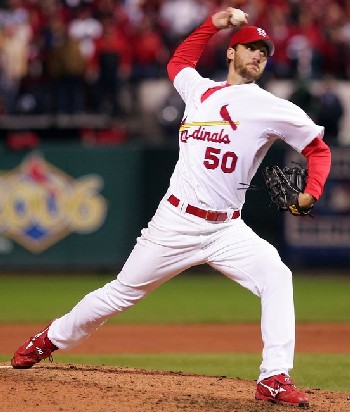
The photo above from him pitching
during Game 5 of the World Series reinforces that concern. Notice
that his Pitching Arm Side (aka PAS) elbow is well above the level
of his shoulders (or
Hyperabducted). I have seen this a couple of times before, and
in both cases it was related to very serious shoulder (e.g.
Labrum) problems.
As with Joel Zumaya, this is too bad. As the photo
above shows, Adam Wainwright achieves a tremendous degree of
separation between his hips and his shoulders. Notice how his belt
buckle is facing Home Plate while his shoulder are still facing
Third Base.
10/27/2006
Joel Zumaya: Hips Rotating
Before Shoulders
As I have said
before, I believe that Joel Zumaya is at an increased risk for
shoulder problems, especially if he is moved into the starting
rotation next year, because he takes his elbows above and behind his
shoulders.
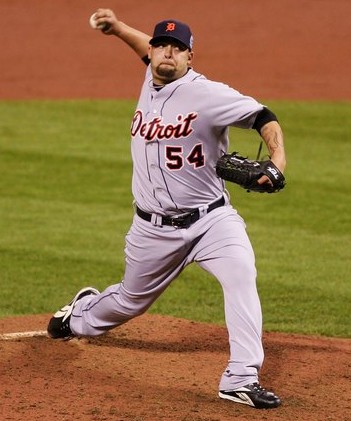
It's too bad, because as the
photo above shows, he does a great job of rotating his hips before his
shoulders. Notice how his belt buckle is facing Home Plate while
his shoulders are still facing Third Base. This large hip/shoulder separation helps to explain his
velocity.
10/27/2006
Jeremy Bonderman: Shoulder
Problems Ahead?
Jeremy Bonderman is another
pitcher that I believe faces an increased risk of shoulder
problems.
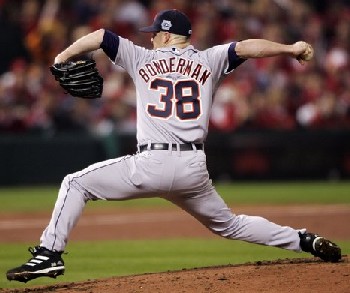
As you can see in the photo
above, taking during Game 4 of the World Series, Bonderman
Hyperabducts his PAS upper arm and takes his elbows both above and behind his
shoulders.
10/26/2006
Good Photo of Chris Carpenter
I was going over the photos from
Tuesday night's game and came across this picture of Chris
Carpenter. There are a number of interesting things to note in it.
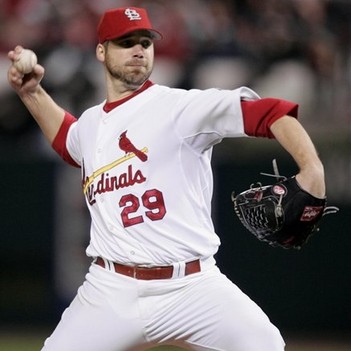
First, you can see how Chris
Carpenter's hips rotate ahead of his shoulders. Notice how his
belt buckle is pointing toward Home Plate while his shoulders are
still facing Third Base. This will help his hips to powerfully
pull his shoulders around.
Second, you can see how Chris Carpenter doesn't really
reverse-rotate his shoulders. Instead, he strides pretty much
sideways to the target.
Third, you can see how Chris Carpenter grips his
curveball. Notice that his middle finger is sitting on one seam
and his thumb is sitting on the opposite seam.
Fourth, notice how Chris Carpenter's palm is facing
Home Plate at this point (and not Second Base). This puts his
forearm in a position of supination which will force him to
pronate his forearm in order to get his palm to face home plate. I
believe that
early pronation will help to protect his elbow by enabling his
Pronator Teres muscle to take some of the load off of his UCL.
Fifth, notice how Chris Carpenters PAS elbow is just
below the level of his shoulders. I believe that this is about the
ideal height for the PAS elbow, from both a mechanical efficiency
and injury-prevention perspective.
Finally, you can see these same things in this side
view of Chris Carpenter, which is from a slightly earlier moment
in time and in which he is also throwing a curveball.
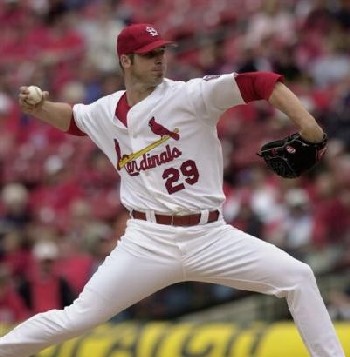
10/25/2006
Major Leaguers and the
Marshall Pitching Motion
For those of you who, like me,
are interested in the ideas of Dr. Mike Marshall, I have added an
essay entitled
Major Leaguers and the Marshall Pitching Motion that
illustrates some of Dr. Marshall's ideas using the motions of a
number of successful major leaguers.
10/24/2006
Kenny Rogers: Crossing The
Line
After hearing about the whole
Kenny Rogers pine tar on his hand thing, I was willing to give him
the benefit of the doubt and assume that he was just trying to
improve his grip of the ball. Hey, I pitch for my over-30 slow-pitch
softball team and know that on a cold night it's extremely hard to
keep your grip on the ball on a night like that. Your fingers get
stiff and the ball gets smooth and slick.
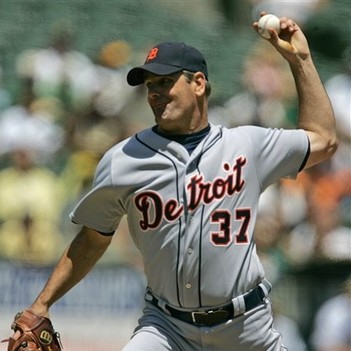
However, while searching my
archives last night, I came across this photo from Kenny Rogers'
July 5, 2006 start. Notice that the same smudge is there on his hand at
the base of his thumb. That suggests to me that he is using the
pine tar to alter the flight of the ball, not just to improve his
grip on the ball.
It also just struck me that the reason the pine tar is
located there on his thumb is probably that his second stash is in
the pocket of his glove. The base of his thumb rubs up against the
stash in his
glove whenever he's adjusting his grip with his hand and ball in his
glove.
10/23/2006
Kenny Rogers: Look For The
Second Stash
Here's my theory about the Kenny
Rogers cheating allegations.
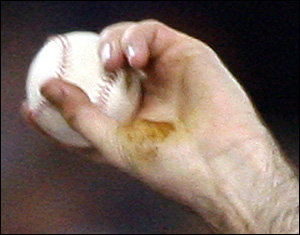
My
theory is that Kenny Rogers WAS cheating and the patch at the base
of his PAS thumb was his "hidden" store of pine tar. In other
words, if he got caught, he could wash it off and say he was
clean (and that of course it got there accidentally). However, he (or Pudge) had a second stash that he was
using.
You see this in the spy movies.
Someone plants a bug in an obvious place so that it
will be found. However, they also plant a second bug that is much better hidden. Once the
first bug is found, the searchers figure the problem is solved and
don't look for the second bug.
The existence of a second stash explains why Rogers' performance didn't
suffer after he was "caught".
This article suggests that his second stash could have been
hidden under the bill of his hat.
At least this whole fiasco has produced
a whole series of detailed photos of how a major league pitcher --
even if he is a cheater -- holds the ball and helps to dispel
the myth of the three point fastball grip that I discussed
below in the context of Tom Glavine. Notice that in the photo
above Rogers has a 2-Seam fastball (aka Sinker) grip, and is
gripping the lower half of the ball with both his thumb and his
ring finger, not just his thumb.
10/20/2006
Sandy Koufax: Hips Rotating
Before Shoulders
I finally found a clean copy of
one of my favorite pictures of Sandy Koufax.
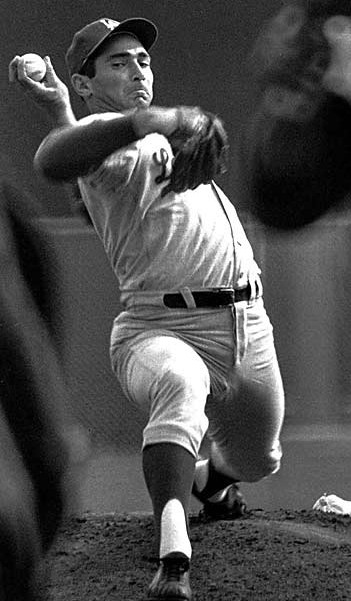
In the photo above, you can see
how Sandy Koufax's hips rotated well ahead of his shoulders.
Notice how his belt buckle is pointing toward Home Plate while his
shoulders are still facing First Base. Other things to notice are
how his Glove Side (aka GS) toe is pointing directly at the
target, how he is pulling his glove into his GS pec, and how his
GS elbow is still at the level of his shoulders (rather than down
at his side).
10/19/2006
Adam Wainwright: Uh oh...
I have been very impressed with
Adam Wainwright's performance. I especially like his curveball.
It's got that 12-6 drop that just kills hitters. That's why I am
concerned by what I see in the photo below.
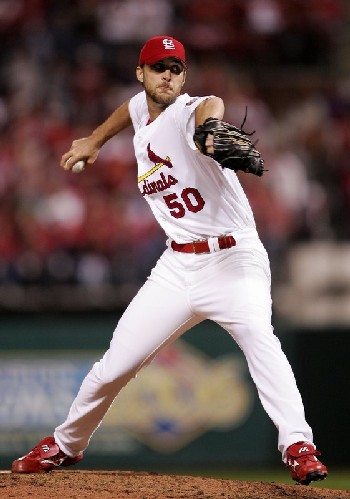
It looks like Wainwright's
Pitching Arm Side elbow is both above and behind his shoulders.
Now, he admittedly doesn't
Hyperabduct his PAS elbow this as much as Aaron Heilman or
Joel Zumaya do, but nonetheless I think it is a concern. I will be
paying close attention to Wainwright's PAS shoulder, especially if
the Cardinals try to turn him into a starter next year.
10/19/2006
Aaron Heilman: Shoulder
Problems Ahead?
I was watching the game the other
night and got a chance to take a look at Aaron Heilman. I didn't
like what I saw.

Like Joel Zumaya and Billy
Wagner, Heilman
Hyperabducts his PAS elbow; he take his PAS elbow both above and
behind his shoulders. I believe that puts a tremendous amount of
strain on the rotator cuff (e.g. Subscapularis) and may lead to
injury problems in the future, especially if he comes out of the
bullpen.
10/18/2006
Beltran Perez: Good Timing
I am always on the lookout for
guys who, like Freddy Garcia, get their pitching arms up earlier
than most. I believe that doing this reduces the strain on the
shoulder.
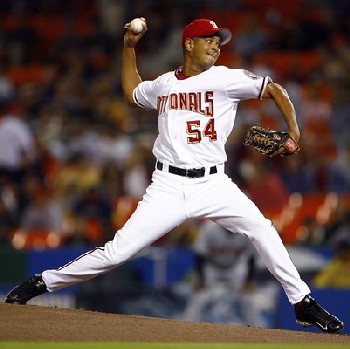
The photo above of Beltran Perez
is an example of what this looks like. Notice how his Pitching Arm
Side forearm is vertical and in the high cocked position before
his Glove Side foot lands on the ground. Also, notice that Perez
isn't showing any signs of
Hyperabduction; his
Pitching Arm Side elbow is just below the level of his shoulders.
10/16/2006
Anthony Reyes: Tipping His
Pitches?
I was watching the Cardinals game
last night, and a couple of things struck me about Anthony Reyes.
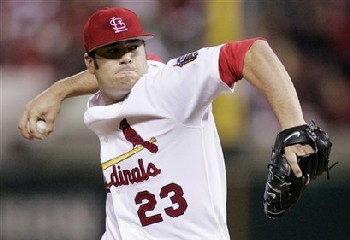
First, I was reminded how high
Anthony Reyes' elbows get above and behind his shoulders. You
can see this clearly illustrated in the photo above that was taken
last night. I believe that this
Hyperabduction of his PAS upper arm puts a tremendous amount of strain
on his rotator cuff (e.g. Subscapularis) and calls into question
his long-term durability. I am also starting to wonder if this
problem is manifesting itself in the problems he experienced at
the end of the season (e.g. not being able to go deep into games).
Second, the commentators were talking about how Reyes
might have been tipping his pitches when he went from the Wind-Up.
While this may be the case (I wasn't really looking at this), I
wonder if a bigger problem is the differential between Anthony Reyes' two
main pitches, his fastball and his change-up. Last night
Reyes' fastball was generally coming in at 90 MPH (Low = 88 and
High = 91) and his change-up was generally coming in at 76 or 77
MPH.
As an aside, you can see Anthony Reyes' change-up grip,
which is a circle change, in the photo above.
Anyway, and as I have said elsewhere, I believe it
is best if a pitcher's change-up is 8% to 10% slower than his
fastball. There are complicated reasons, that have to do with
the perceptual thresholds of the human visual system, why I
believe this. However, suffice it to say that I believe that a
change-up that is coming in 8% to 10% slower than one's fastball
is coming in hard enough that it's not obviously a change-up, but
slow enough that it will still screw up a hitter's timing.
I don't think it's a coincidence that Greg Maddux, Jeff
Suppan, and many other effective "finesse" pitchers have
change-ups that follow this rule of thumb.
If you buy this logic, then I believe the problem
with Anthony Reyes' change-up may be that it's too slow. Given that
his fastball comes in at 90 MPH, the rule I state above would say
that his change-up should come in at somewhere around 81 or 82
MPH. However, Reyes' 76 MPH change-up is more like 15% slower than
his fastball.
Could it be that that large differential between
Anthony Reyes' fastball and his change-up makes it obvious to a
hitter which pitch is coming?
Finally, I noticed something odd about Reyes'
change-up. It didn't look like a standard change-up to me.
Instead, give how Reyes' change-up dove down near the plate, I
wonder if he's throwing kind of a hybrid between a circle change
and a curveball. Of course, the problem with hybrids (e.g. the
slurve, which is a hybrid of a slider and a curve) is that they
can end up being less effective than either pitch on its own. it
could be that Reyes' "curve-up" or "change-uvre" -- if that's
indeed what it is -- is too slow to be a good change-up and
doesn't curve enough to be a good curve.
Any thoughts? If so, then
e-mail me.
10/14/2006
Wilfredo Ledezma: Hips
Rotating Before Shoulders
I am always on the lookout for
new photos that illustrate the concepts that I teach.
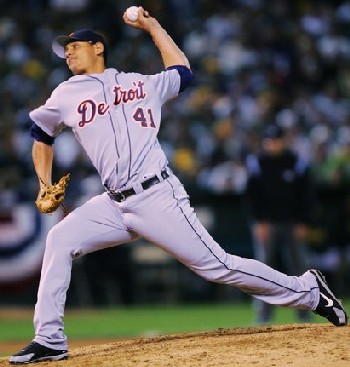
The photo above of Wilfredo
Ledezma pitching in the ALCS is a great example of what the hips
rotating before the shoulders, and a large hip/shoulder
separation, looks like. Notice how his chest is pointing at 1B
(since he's a lefty) while his belt buckle is pointing at home
plate. Also, notice how the lines down the front of his uniform
curve sharply to the left.
This photo isn't quite as instructive as the
photo below of Casey Fossum (since Ledezma isn't as much of a
string bean), but it's close.
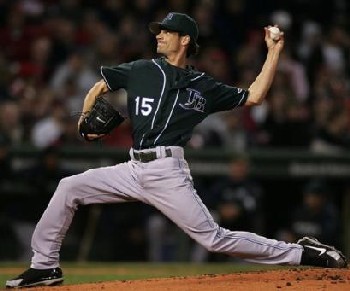
10/13/2006
Pitching Myth Busters:
The Three-Point Fastball Grip
When I first started getting into
the whole pitching thing, one piece of advice that I repeatedly
came across was that a pitcher (or a fielder) needs to have a
three-point grip on a fastball. The ball needs to be held between
just the index finger, middle finger, and thumb so as to maximize
the velocity of the ball as it comes out of the hand.
The problem is that when I tried to do this, I couldn't
get a stable grip. The kids I coached also couldn't do this since
their hands were smaller than mine.
As a result, I just resigned myself to always gripping
the ball wrong.
Well, over the past few weeks I have started collecting
pictures of how big-league pitchers actually grip the ball and
have come to see that the three-point fastball grip is overrated,
if not a complete myth.
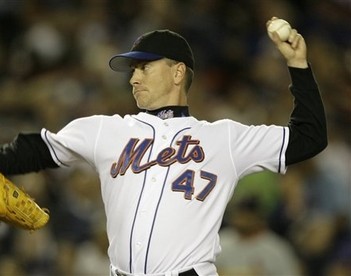
The photo above of Tom Glavine
was taken last night and shows his 4-Seam Fastball grip. As you
can see, Glavine actually grips his 4-Seam Fastball with a
four-point grip. The ball is gripped between his index and middle
fingers on top and his thumb and ring fingers on the bottom.
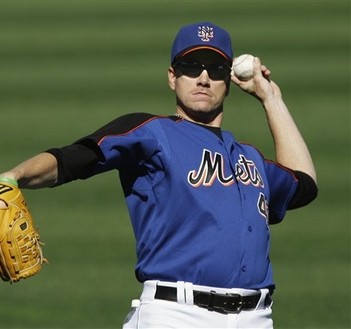
You can see the same thing in the
photo above of Glavine taken just a couple of days ago. Notice how
he is gripping the bottom of the ball with both his thumb and his
ring finger.
So why are pros like Glavine able to get away with this
and not turn their fastballs into change-ups?
They are able to do this because what really matters,
in determining how fast a ball will come out of the hand, is the
amount of skin that is on top of the ball, not the amount of skin
that is under the ball.

As this photo of Jeff Suppan
demonstrates, when throwing a fastball the last thing the ball
touches are the index and middle fingers. As the wrist snaps
backwards through the release, the ball loses contact with the
fingers under the ball. As a result, they have relatively little
impact on the release speed of the ball.
That means it's perfectly acceptable to grip a fastball
with a four-point grip rather than a three-point grip.
10/12/2006
The Problem With Throwing
Sidearm
My columns below about throwing
sidearm generated a decent number of interesting questions from
readers. That includes this one from Mike G...
I was just wondering, if the arm is fully
extended out at the time of release, of which I believe also, then
is, what is considered throwing overhand any less strenuous on the
arm as throwing sidearm? I was just wondering since the tilt of
the shoulders is the only difference?
This is a great question, and let
me see if I can come up with a scientifically valid answer to it.
First, it would seem that, since the only difference
between throwing overhand and throwing sidearm is the amount of
shoulder tilt, that there shouldn't be a difference. If that was
true, then coaches shouldn't mind whether their guys threw
overhand or sidearm.
However, that doesn't seem to be that case.
The Journal of the American
Academy of Orthopedic Surgeons contains an article entitled
Shoulder and
Elbow Injuries in the Skeletally Immature Athlete in which the
authors state that pitchers who throw sidearm are three times more
likely than overhand throwers to experience injury problems.
Why would that be the case?
It appears that the root cause of the problem is that
there are distinct mechanical differences between (probably some) sidearm throwers
and overhand throwers, and those differences make throwing sidearm
riskier. For example, in an article entitled First Rib
Stress Fracture in a Sidearm Baseball Pitcher: A Case Report
the authors say...
The motion analysis of the pitching in this
case demonstrated that the sidearm style induced much more
horizontal abduction in the shoulder at the top position than
did the overhand style.
This matches up with my experience.
One of the reasons I have gotten into the whole pitching thing
is that I permanently damaged my arm when I was a kid, and I
wanted to make sure my son didn't run into the same problems. When
I was a kid, I threw from a sidearm to submarine arm slot.
What I think I did that caused my problems was that I would break
my hands high and take my PAS hand directly back toward 2B, rather
than taking my PAS hand down, out, and then up. Then, as my hand
was still moving back toward 2B, I would start rotating my
shoulders. This allowed me to get a lot on the ball, but it also
put a tremendous amount of stress on my shoulder as it experienced
a larger than average amount of adduction (aka horizontal
abduction).
So what's the bottom line?
While it may be possible for a pitcher to throw safely
from a sidearm arm slot, coaches have to be very careful to ensure
that pitchers break their hands properly. That means swinging the
pitching arm down, out, and then up and into the Ready position
and not picking up the forearm and taking it up and back to the
Ready position.
10/11/2006
Pitching Myth Busters:
Arm Slot - Perception vs. Reality
Yesterday at lunch I had a
conversation with a guy who has written a number of books about
sports (one of which was given to my son). Some of the things he
said didn't ring true with me, so I decided to take a look at the
book my son was given.

Arm Slot: Perception
In the book, I found a diagram
very much like the one above that tried to explain the differences
between the arm slots that pitchers throw from. This diagram
suggests that the difference between arm slots is how much the
pitcher's elbow is bent as they release the ball. It explains that
a sidearm pitcher's elbow is fully extended at the release point
while an overhand pitcher's elbow is bent 90 degrees.
The problem is that, when you are talking about kids
who are older than 10 or so, THIS IS WRONG!

Arm Slot: Reality
The reality is that, due to the
forces involved, every pitcher's elbow is fully extended at the
release point. The thing that determines their arm slot is
how much their shoulders are tilted.
Why, you ask, is this a big deal?
It's a big deal because how can you trust the advice of
someone who doesn't understand what the arm actually does during
the throw? Some of what they say is based on a misconception of
the throwing motion, and some of their advice may be wrong (if not
dangerous).
Of course, this common misconception can be used to
evaluate potential pitching coaches. By asking them what the arm
does, and how much the elbow is bent, through the release point
you can quickly determine who knows what they are talking about
and who doesn't.
10/5/2006
Pitching Myth Busters:
Rapid Internal Rotation of the Upper Arm
is an Important Source of Power
If you read the technical (e.g.
medical) literature about baseball pitching, one statistic that
you will frequently come across is that much of a pitcher's power
results from the rapid internal rotation of the upper arm (e.g.
Humerus). Some people believe that a pitcher's upper arm
internally rotates up to 7000 degrees per second. I was
immediately skeptical about this claim when I first came across
it, and believe that it is wrong. Let me use the photo below of
Pedro Martinez to explain my skepticism.
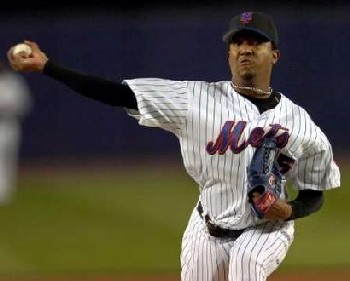
I believe the photo above blows a
hole in the idea that the rapid internal rotation of the upper arm
is responsible for much of a pitcher's power. Notice that in the
photo above, Pedro Martinez's upper arm is still externally
rotated (his palm is facing up). It is impossible for the rapid
internal rotation of his upper arm to generate much power, because
his elbow is extended and as a result his hand is pretty much on
the axis of rotation.
Try putting your arm in this position and see how much
you can get on the ball.
I doubt if it's very much.
I believe that the idea that the rapid internal
rotation of the upper arm is responsible for much of a pitcher's
power is based on a fallacy; that a pitcher's elbow is bent 90
degrees at the moment that the rapid internal rotation of the
upper arm occurs. I grant you that, in that case your could get
something on the ball because the ball would be the length of the
forearm from the axis of rotation.
However, the above photo makes it clear that the elbow
is not bent 90 degrees at the moment that the rapid internal
rotation of the upper arm occurs. Instead, the elbow is fully
extended at this moment.
So what is the primary source of a pitcher's power?
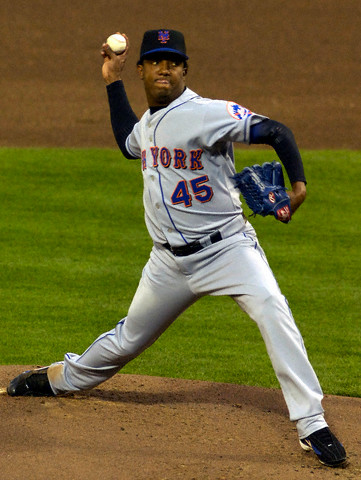
As I have said before, and as
this photo of Pedro Martinez illustrates, it's the rotation of the
hips before the shoulders. This stretches the muscles of the torso
and enables them to powerfully the the shoulders around.
10/5/2006
Pitching Myth Busters:
The Myth of Arm Slot
When it comes to pitching, people
are always talking about arm slot, how it's genetic, and how you
shouldn't try to change it.
I think that's garbage.
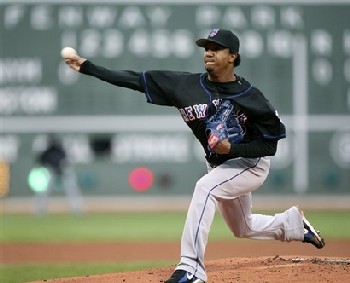
The thing that makes Pedro
Martinez throw from a sidearm arm slot is that he doesn't tilt his
shoulders as they are pulled around by his torso.

In contrast, the thing that makes
Tom Glavine throw from a 3/4 arm slot that he tilts his shoulders
roughly 45 degrees as his shoulders come around.
It's that simple.
10/1/2006
Look At All The Knuckle
Curves!
I believe that a knuckle
curveball (aka knuckle curve) is the best kind of curveball for a
young pitcher to throw. This is because it is thrown like a
fastball and the topspin comes from the rapid extension of the
index finger rather than the twisting of the wrist or forearm.
I used to think that major league pitchers who threw
the knuckle curve were few and far between, but in the past few
days I have come across a number of photos of big league pitchers
throwing the knuckle curve.




Above are four photos of Mike
Mussina throwing his knuckle curve.

Here's a photo of Bobby Jenks of
the White Sox throwing a knuckle curve.

Here's a photo of Danny Haren of
the A's throwing a knuckle curve.

Here's a photo of Dustin Moseley
of the Angels throwing a knuckle curve.
The
Pitching Mechanic - September 2006
|